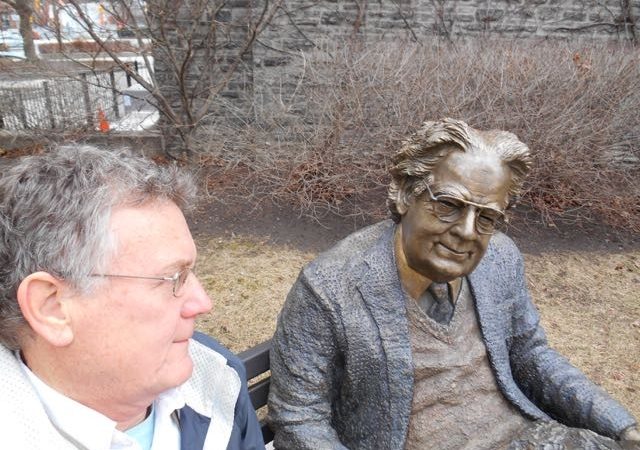Fairy-Stories, Snowdays, and Rhyme
John Hoy visits with Northrup Frye, Toronto
Within his foundational essay “On Fairy-Stories” J.R.R. Tolkien isolates Faërie, the Perilous Realm or Shadowy Marches wherein fairies discover their being, and he describes three faces by which fairy-stories may be recognized: the Mystical, the Magical, and the Mirror (looking toward the Supernatural, Nature or Mankind). Myself being a backward and doubtful being, skeptical at the best of times, arrogant when it serves, I nevertheless allow Tolkien’s entrancing spell, releasing my own words, deploying poetic phantoms and a few robotic puzzles. At the same time, applying just a tad more tangibility on a winter’s morning (school has been cancelled), I throw another log on the fire and grip more tightly my shepherd’s plaid—the great Scottish wrap shouldered by actual shepherds and dreamers wandering into and out of antiquity. Any pastoral people off the veldt, steppes or deserts would own such a shawl formed of animal skins or local fabric, and before a later day brought dyes to such homespun these woven wraps carried simple, unfussed colors. This particular morning, the undyed black wool and white wool of the ancient “check”—checkerboard pattern—seems straight out of Faërie, since I readily drift away as I hold it, and scale seems entirely within my control. I am only echoing Tolkien as I note that effect; he has told me this morning in his essay that stories “in the fairy-tale setting…open a door on Other Time, and if we pass through, though only for a moment, we stand outside our own time, outside Time itself, maybe.”[1] But as I turn back from the stove, I find myself confronting the ghost of Robert Burns. Morning coffee helps the effect, but indeed I have slipped into spaces calloused and venerable, back to earlier ages—dust and the canyons carved by actual bookworms, flakes of paper, wood smoke and threads of wool.
I recognize fresh expression of a point I saw years before, the separate powers of blackness and whiteness. Tolkien of course put a set of colors to work in his Lord of the Rings. What is important this morning, as I ponder old stories, is the mythology or public “reality” based in hopes, expectations and convenience. The great philologist (word-origin hero) Tolkien was not sympathetic as people such as publishers found all-too-handy boxes into which they might pack his work. He certainly should be alarmed at my particular views, folded as I am in my black-and-white plaid.
The blackness of Tolkien’s Ring-Wraiths and the overly simple darkness of the Evil Side is simply too gratuitous, and it brings impact, right to today. No matter how cute his hobbits, how levelheaded his wizard, Blackness and its relatives instead might well bring a glorious color of life, warmth and enlightenment—we readers of all interests must continue to remind ourselves. Tolkien may have been naive to imagine he was simply building his own, private new cosmos, but he appears not to have cared who was in and who was left out. Of course, the native South African had been prompted by devastating world wars to narrow his sense of the world itself. I pull up short, an array of wordy powerhouses whispering in the corner, and Martin Luther King, Frederick Douglass, Sojourner Truth, Ralph Ellison and Robert Burns pull me toward the traditionary True Thomas Rymour.
 Actually, Tolkien knew Rymour well, spelling him out as “True Thomas the Rhymer”, meeting more contemporary awarenesses of 1930s Britain. Rymour (let’s call him) had the gift of prophecy in popular European folk songs and stories from the Middle or earlier centuries. A comfort to agrarian folk but co-opted by military strategists to precipitate favored battle outcomes, Rymour like Arthur or Merlin found he had other lives. As I have discovered, he continues to our later day, but in order to recognize his influence it helps to repose with a range of other stories, including those of Arthur, Merlin, Frodo and Gandalf. But the most crucial mythical personality, and another reason that I begin to lose patience with J.R.R. Tolkien no matter his genius, is a more unsettling if more undeniable presence: a striking female figure standing to the side, shouldering her own mantle of magical colors, out of Robert Burns’s poem “The Vision”: Coila.
Actually, Tolkien knew Rymour well, spelling him out as “True Thomas the Rhymer”, meeting more contemporary awarenesses of 1930s Britain. Rymour (let’s call him) had the gift of prophecy in popular European folk songs and stories from the Middle or earlier centuries. A comfort to agrarian folk but co-opted by military strategists to precipitate favored battle outcomes, Rymour like Arthur or Merlin found he had other lives. As I have discovered, he continues to our later day, but in order to recognize his influence it helps to repose with a range of other stories, including those of Arthur, Merlin, Frodo and Gandalf. But the most crucial mythical personality, and another reason that I begin to lose patience with J.R.R. Tolkien no matter his genius, is a more unsettling if more undeniable presence: a striking female figure standing to the side, shouldering her own mantle of magical colors, out of Robert Burns’s poem “The Vision”: Coila.
As I note, settled in my Scottish black-and-white plaid, books and phantoms all around me, Coila was the ethereal spirit or voyaging being (aka wight) who suddenly formed in front of the poet when he was most discouraged, winter of early 1785. At that time, Burns was impoverished, desolate, cold, his own plaid was full of holes and he was ready to give up writing songs and poetry and find a paying job. Expressing something of Thomas Rymour, Coila traveled over the seas to manifest in the poet’s cottage, insisting on attention (despite rats and the winter wind) in order that the poet might maintain his central, most personal hopes, that he should trust that his rhyming ought to continue, and that he was in a marvelous place to take up a more “universal plan” which she knew was central to all art and human enterprise. She even braced her argument with mention of Scottish heroes of the past.
As I have come to discover, as James Augustus Henry Murray knew and accepted in a way that perhaps Tolkien would not (another philologist, Murray was primary editor of The Oxford English Dictionary), and others might refuse to imagine—the magical soul Coila was black.
Robert Burns held to myth because of the harsh social realities of his own day, so he had better not go admitting to be anti-British, anti-European, “anti-civilization”. Instead, the quintessential Scotsman stepped along barely known, faintly visualized Shadowy Marches (as Tolkien might identify them); that is, he kept to the edges, among the folk and their naming traditions, many of them desperately poor. As we can now begin to see more fully, visiting spirit Coila was herself a devoted being whose hope for the futures of all (that universal plan) might resonate and shine and, with the necessary help of Burns and his artistic heirs, pull European culture and history out of a long, slow moral decline around race and class, even color, and perhaps even raise up slaves of his day, oppressed African Americans and Anglo-Africans, as well as Africa itself (with some especial shout-out for those from Senegal and Gambia, home turf for the model for Coila), as she reached out and raised up one destitute poet. To understand her full meaning, and just how James A. H. Murray came to know as much as he did, we had better thank black thought leaders of later days for opening white eyes, but we must also rediscover the daring wight True Thomas Rymour and his entrancing power and foresight. Wrapped in the venerable black-and-white of my plaid I may have to pay a visit to the 1936 John Hoy of Ethiopia, to his quaintly jocular journalist creator Robinson MacLean (enthusiast for Emperor Haile Selassie) as well as to MacLean’s fascist adversary Evelyn Waugh—prescient as he spoke for Italy on the eve of World War II. The continuation—that is, details—of this story I call Seeking Phillis, or The Empress Revealed. Another log on the fire, in retirement this morning and down the road, I take them all on.
[1] “On Fairy-Stories”, Tree and Leaf, 32.



